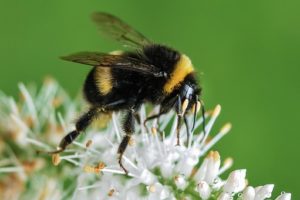Bumblebees – the Harbingers of Spring
Garden and landscape plantings help sustain bumblebees when they emerge in early spring.
By Thomas Christopher
During this season of early spring, long before the honey bees emerge from their hives, our native bumblebees are already hard at work. Their large, fur-covered bodies and an ability to generate body heat by flexing their muscles enables bumblebees to stay active in chilly temperatures that incapacitate honey bees and most other pollinating insects. This makes bumblebees especially valuable to early spring wildflowers, particularly in cool, northern climes such as our own. In short, this is an insect well worth cultivating.
It is the bumblebee queens we see at this time of year. They burrowed down into the leaf litter or loose soil last fall to hibernate through the winter, but have emerged now to forage for pollen and nectar and establish nests in abandoned rodent holes, or above the ground in tufts of grass, old birds’ nests, or in cavities in dead trees and rock piles. Inside each of these nests the queen begins to store honey and pollen, and lay a generation of eggs that hatches into worker bees. The workers then take over the job of foraging while the queen devotes herself to raising a new generation of queens and male drones who will mate and start the cycle all over again.
Different species of bumblebees have different length tongues, to reach into different shapes and sizes of flowers. Collectively, then, they can handle a wide range of pollination tasks. In addition, they have a special trick. Certain flowers from which it is difficult to extract pollen the bumblebees will “buzz pollinate” — they grab onto the blossoms and then vibrate their flight muscles to rapidly shake the flowers and dislodge their pollen. This is the most efficient way to pollinate such garden favorites as tomatoes, eggplants and blueberries, and bumblebees are particularly important to these crops.
Unfortunately, like many pollinators, bumblebees are declining in numbers. This seems to be a result of forces largely beyond the control of individual gardeners, such as habitat fragmentation, agricultural pesticide use, introduced parasites and diseases and climate change. What you and I can do, however, is to make our landscapes refuges for bumblebees.
This we can achieve partly through a sympathetic planting. Because bumblebees don’t store large honey reserves like honey bees, they need an uninterrupted succession of nectar and pollen-rich flowers through the growing season. The Xerces Society (https://xerces.org/), a non-profit environmental organization dedicated to the preservation of invertebrates, recommends the following array of native flowers for Northeastern gardeners: spotted geranium (Geranium maculatum), Dutchman’s breeches (Dicentra cucullaria), sundial lupine (Lupinus perennis), smooth penstemon (Penstemon digitalis), beebalm (Monarda fistulosa), butterflyweed (Asclepias tuberosa), field thistle (Cirsium discolor), narrowleaf mountain mint (Pycnanthemum tenuifolium), blue giant hyssop (Agastache foeniculum), showy goldenrod (Solidago speciosa), and New England aster (Symphyotrichum novae-angliae).
Pussy willows and early-blooming fruit trees such as apples, plums and cherries are welcome early spring food sources for bumblebees. These pollinators also visit the flower garden in summer, where sunflowers, delphinium, snapdragons, lavender, hollyhocks, cosmos, and cornflowers are favorites. In general, to attract bumblebees, plant old fashioned or heirloom varieties with simpler, non-double flowers. Some herbs such as mint, oregano, and catnip are also butterfly attractors. Pumpkins, strawberries, melons and zucchinis will draw bumblebees to the kitchen garden, responding to their attentions by bearing bigger crops.
A very useful resource is a database (at http://www.xerces.org/lbj) developed by the Xerces Society in partnership with the Ladybird Johnson Wildflower Center. This directory of plants can be customized to search for plants adapted to a particular state, bloom time, bloom color, and other factors so that users may develop lists suited to their needs and their tastes.
A final step that will favor bumblebees is to be a bit relaxed in your garden cleanup. Leave a litter of leaves and maybe a fallen log or some taller bunch grasses somewhere in your yard to accommodate over-wintering queens. Minimize your use of pesticides; do not spray plants that are in bloom and avoid the use of systemic insecticides such as neonicotinoids. The bumblebees will benefit and so will your garden.
Thomas Christopher is the co-author of “Garden Revolution” (Timber Press, 2016) and is a volunteer at Berkshire Botanical Garden. berkshirebotanical.org
Be-a-Better-Gardener is a community service of Berkshire Botanical Garden, one of the nation’s oldest botanical gardens in Stockbridge, MA. Its mission to provide knowledge of gardening and the environment through 25 display gardens and a diverse range of classes informs and inspires thousands of students and visitors on horticultural topics every year. Thomas Christopher is the co-author of Garden Revolution (Timber press, 2016) and is a volunteer at Berkshire Botanical Garden. berkshirebotanical.org.




